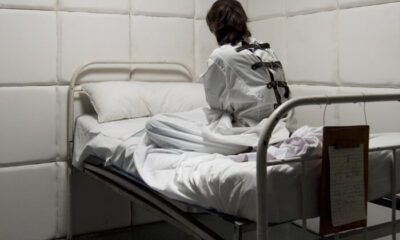Travel
Pickpocketing on the London tube: Theft soars by 83% with popular tourist destinations key targets
Popular tourist destinations are being targeted as theft soars on the London Underground.
Pickpocketing is rife on the London Underground, new statistics have revealed.
Crime on the Tube increased by 56 per cent overall between April and September this year, compared to the same period last year, according to data from Transport for London (TfL).
Theft soared by 83 per cent, while robberies were up by 107 per cent. This is despite passenger numbers falling by 11 per cent.
“We know that thieves target busy places including our public transport networks and we are working closely with the police to tackle theft,” a TfL spokesperson tells Euronews Travel.
While theft is nothing new on London’s trains, it’s uncommon to see the organised gangs of pickpockets that operate in major European cities like Paris, Barcelona or Milan.
But with the latest spike, visitors to the UK capital should be on their guard.
Where and when are you most likely to get pickpocketed on London’s Tube?
As you might expect, busy transport and tourist hubs are key targets for pickpockets.
If you’re arriving on the Eurostar at King’s Cross St Pancras, take care when getting on the Tube. On the London Underground, 39 per cent of thefts – taking property without consent – were committed at stations, and this one was a hotspot.
Leicester Square, in the heart of the West End Theatre District, and Oxford Circus – the gateway to Europe’s busiest shopping street – were also singled out.
The Northern Line was the most targeted route for on-train thefts with 676 offences, followed by the Jubilee Line and the Piccadilly Line.
Though less common, robberies were more likely to take place at stations (59 per cent) than on trains. East London shopping hub Stratford had the most targeted station, seeing 14 offences between April and September.
Be particularly vigilant if you’re visiting London on a weekend, as 55 per cent of thefts on the Underground were committed between Friday and Sunday. Avoid peak travel times if you can: 23 per cent of thefts occurred during the evening rush hour (5pm to 8pm).
Where are you most likely to get pickpocketed on London buses?
Although crime hasn’t risen as much on London buses as on the Tube, you should still remain wary.
Westminster – where you’ll find Big Ben, the Houses of Parliament and Buckingham Palace – saw the highest percentage of bus-related offences (14 per cent). It was followed by Southwark (9 per cent), home to Borough Market, The Shard, Tower Bridge, and the Tate Modern.
The top three boroughs for bus-related robberies between April and September were Croydon in south London, Haringey in north London, and Westminster.
32 per cent on Londoners feel worried on public transport
In the face of rising crime rates, 32 per cent of Londoners say they’ve felt worried on public transport in the past three months – especially on the Underground and buses.
Drunken behaviour on both modes of transport was a key concern, especially for female passengers. Anti-social behaviour by youths and school children was more likely to be encountered on buses, especially by men.
Overcrowding, threatening behaviour and people begging are also sources of concern, according to a customer survey carried out by TfL.
Worrying incidents have led 7 per cent of people in London to temporarily stop using public transport altogether.
What is being done to make London transport safer?
London transport union RMT has warned that staff cuts have paved the way for increased crime on the Underground.
“These soaring crime rates come as no surprise to tube workers that are on the frontline every day in this increasingly hostile environment,” says RMT general secretary Mick Lynch.
TfL says it is deploying plain clothes police patrols and other enforcement action in busy hotspots for crime. It is also using its extensive CCTV network to track down offenders.
Messaging on posters and tannoys is being used to encourage customers to keep their belongings safe and report any suspicious activity to police.
You can do this by informing a member of staff, texting the British Transport Police on 61016, or via the free Railway Guardian App.
To report an incident on the bus network, head to www.met.police.uk or call 101. But in an emergency or if the suspect is still on scene, you should call the emergency services on 999.
How to keep your belongings safe while travelling
As well as having your wits about you, there are a few ways you can keep your belongings safe while travelling.
Using a money belt or a bag with a secure zip can prevent pickpockets accessing your valuables. Place non-valuable items on top of valuables in your bag, and wear your backpack on your front while on the Tube.
Avoid travelling with important documents like your passport, large sums of cash or big-ticket items like your laptop – these will be safer left in your hotel room.
Prepare for the worst by backing up the files on your phone, adding an ICE (‘In Case of Emergency’) contact to your lock screen, and switching on ‘find my phone’ services. Scan important documents and email the images to yourself. If you’re travelling with a suitcase, a tracking device like an AirTag can help you keep tabs on it if it goes missing. And get travel insurance.
Travel
Sicilian town bans Mafia souvenirs to clean up its image before it becomes 2025 capital of culture
The ban comes as Agrigento readies itself to be Italy’s capital of culture next year and aims to shine the spotlight on its cultural riches rather than Mafia heritage.
In souvenir shops around the Italian island of Sicily, you’ll often find Mafia-themed merchandise from magnets and t-shirts to bottle openers and shot glasses.
The Sicilian mafia continues to operate on the island, engaging in criminal activities like extortion, narcotrafficking and kidnapping.
Agrigento is a town in southern Sicily still struggling with Mafia control – and it is also set to be the Italian Capital of Culture in 2025.
In a bid to change its international image and crack down on the glamourisation of the criminal organisation, the town has decided to ban the sale of Mafia-themed souvenirs.
Francesco Miccichè, the mayor of Agrigento, has brought in a ban on the sale of souvenirs that feature the Mafia.
It is common to find images and symbols of the underworld organisation on merchandise, including Sicilians in traditional dress holding a sawn-off shotgun known as a ‘lupara’.
The ordinance hopes to change the way tourists see the town and send a clear message that the activities of the criminal organisation are not condoned by local authorities.
“Considering that the sale of such products in the territory of Agrigento humiliates the local community, which has been committed to spreading the culture of legality for years, I order a ban on the sale of any type of object that praises, or refers in any way and form, to the mafia and organised crime,” the mayor told Italian press.
The local police force has been given powers to inspect gift shops in the town and issue fines if prohibited products are found. How much businesses will have to pay has not yet been confirmed.
Agrigento cleans up its images as it prepares to be Italy’s Capital of Culture in 2025
The ban comes as Agrigento readies itself to be Italy’s capital of culture next year and aims to shine the spotlight on its cultural riches rather than Mafia heritage.
The city council says the cultural programme will include 44 new projects which explore humans’ relationship with nature.
One of the most important events will be a concert by the Italian operatic pop trio Il Volo at the Valley of the Temples.
Tourists already flock to this UNESCO heritage site with archaeological remains that date back to when the island was an Ancient Greek colony in the 6th and 5th centuries BC.
The city proper is a palimpsest of ancient, medieval, Baroque and modern architecture and there is a noteworthy archaeological museum.
Travel
Want to get paid to move to Spain? Extremadura is luring digital nomads with €15,000 grants
Digital nomads may be unwelcome in many places but one area of Spain is luring them with grants.
Once considered beneficial to a community, digital nomads have become unwelcome in many areas of Europe, accused of aggravating gentrification and pricing out the local population.
But one region of Spain is still keen to host remote workers – so much so that it is offering financial aid to those who relocate there.
Extremadura, an autonomous community bordering Portugal, is one of Spain’s lesser visited regions but nevertheless is home to wild nature reserves, fauna-filled mountain ranges and a capital scattered with Roman ruins.
Here’s who is eligible for the grant to move to Extremadura and how to apply.
You can get paid to be a digital nomad in Spain’s Extremadura
The regional government of Extremadura is offering digital nomads up to €15,000 to move to the area.
The autonomous community has one of the lowest populations in Spain and is one of the least-developed regions. It has one of the country’s lowest GDPs per capita and one of the highest rates of unemployment at 17.6 per cent compared to the national average of 11.9 per cent.
To bolster both the population and the economy, authorities in Extremadura have earmarked €2 million that will be used to aid the relocation of 200 remote workers and digital nomads to the region.
As well as receiving financial aid, digital nomads can enjoy a low cost of living compared to many other areas in Spain. When compared with the Spanish capital Madrid, the Extremadurian city of Badajoz costs on average 30 per cent less for meals out, public transport and utilities, according to Numbeo.
According to regional authorities, Extremadura lacks in transport infrastructure but has above national average fibre optic and mobile coverage.
Who can apply for Extremadura’s digital nomad grants?
Extremadura is targeting remote workers who are highly qualified professionals in the tech industry.
You must be able to work completely remotely and online “through the exclusive use of media and IT systems, telematics and information fields.”
Those who wish to apply have to commit to maintaining a remote job and living in Extremadura for at least two years.
Both those living in other regions of Spain and those living abroad are eligible as long as they have not lived in Extremadura in the previous six months.
Foreign nationals may apply, but must be resident legally in Spain and be in possession of a foreign identity number (NIE) as found on their green EU certificate or non-EU TIE card.
Non-EU nationals can also apply as long as they are already participating in Spain’s digital nomad visa scheme.
Those not in possession of a digital nomad visa would need to apply for this first and have it approved by Spanish authorities as well as obtain a residency document before applying for the Extremadura scheme.
How much funding will digital nomads receive?
Women, young people under 30 years old and those who relocate to towns in Extremadura with populations less than 5,000 are eligible for a €10,000 grant. Others will receive €8,000.
After two years, those in the first category who choose to stay on another year will receive a second payment of €5,000 while the others will be given €4,000.
When can digital nomads apply for the Extremadura grant?
The date when applications open has not yet been confirmed but authorities say it will be the day after publication of the scheme in the Official Gazette of Extremadura, likely to be around mid-September.
Authorities say applications will stay open until all the funds to cover around 200 digital nomads have been allocated which will be no less than a month but no more than a year.
How can digital nomads apply for the Extremadura grant?
Applications have to be submitted electronically using the Extremadura General Electronic Access Point. Applicants need to be in possession of a digital certificate or electronic Spanish ID card which allows for electronic identification.
You must submit your application form along with an official document issued by your country or another region in Spain to prove your current place of residence and a certificate from your employer authorising you to work in Extremadura or remotely in Spain or, if you are self-employed, a document detailing the terms and conditions in which you will carry out your professional activity remotely.
If you are moving from another Spanish region, you will need an original report supplied by the General Treasury of Social Security showing you are up to date with social security payments, a document certifying you are up to date with your tax payments and a certificate proving you don’t have any debts with the Treasury of Extremadura.
Documents not in Spanish need to be accompanied by a sworn legal translation certified by a professional.
Applicants will hear within three months if they have been successful.
Those successful need to register with a municipality in Extremadura to get a padrón certificate (a local record for people residing in a Spanish municipality) within three months.
After this, you have a month to request payment of the grant, which will be made in a single transaction.
Travel
100ml limit on liquids to return to all EU airports from September
The latest generation of scanners allows passengers to carry electronic devices and liquids without quantity restrictions, but the European Commission questions their reliability and calls for a temporary restoration of the previous model.
Passing through airport security can be a tedious part of the air travel process but some European airports had managed to speed it up thanks to the installation of state-of-the-art scanners, which allow passengers to carry electronic devices and cosmetics of any quantity in their luggage without having to take them out.
But despite the equipment’s positive reception, Brussels recently called for a return to the previous model of limiting liquid containers to 100 milliliters.
Efficient but insufficient
The C3 EDSCB technology, as these advanced scanners are called, displays high-resolution three-dimensional images of baggage contents from CT scans and can easily detect explosive components in all kinds of cosmetics, liquids or electronic devices.
Passengers therefore don’t need to open suitcases or take out some of their belongings, which can create delays, and only have to pass through a metal detector.
But its effectiveness was called into question by a technical report that the Commission sent to the European Civil Aviation Conference (ECAC) last May, according to which the software of these scanners cannot guarantee their reliability for containers with a content of more than 330 milliliters.
Then on July 31, Brussels announced the decision to apply “temporary” restrictions to these C3 explosives detection systems as a “precautionary measure” until “certain technical problems are solved”, a Commission spokesperson said. Officially, however, “the Commission has not changed its opinion on the quality of this new generation of scanners and their performance has not been called into question”, the spokesman added.
Airports already using the C3 model will now have to switch back to the traditional X-ray scanner, whose technology is insufficient to show in detail the interior of objects and thus detect explosive material in liquids.
Financial losses for airports
These new scanners are “eight times more expensive” with maintenance costs “four times higher”, so airports that have already invested in these new scanners to improve the passenger experience “will be heavily penalised, as the benefits associated with the use of this state-of-the-art technology will hardly materialise”, the Airports Council International Europe (ACI) said in a statement.
“Security is non-negotiable, it is one of the top priorities of European airports. Therefore, all airports will fully comply with the new restriction. However, airports that have been early adopters of this new technology are being heavily penalised, both operationally and financially,” ACI director general Olivier Jankovec said.
“The decision to now impose significant restrictions on its use calls into question the confidence that the industry can place in the current EU certification system for aviation security equipment,” he added.
Most of the passengers interviewed by Euronews at Zaventem airport in Belgium said they were used to not travelling with liquids and trying to leave electronic devices at home, so this change in regulations would not affect them too much. Those who had encountered the high-tech C3 scanners or the advanced body scanners at an airport, however, recognised a fundamental difference in the ease with which they gained access to boarding gates.
Nevertheless, the response is unanimous among airport staff and travelers alike: everyone wants to start their holiday as soon as possible and as easily as possible. To this end, those who have decided to postpone their break in September should make sure that sun cream and beauty products do not take up more than 100 milliliters if they do not want to waste any more of their free time at an airport checkpoint.
-

 Politics5 days ago
Politics5 days agoPoland’s Former Prime Minister Mateusz Morawiecki Eyes Leadership of European Conservatives and Reformists
-

 EU & the World5 days ago
EU & the World5 days agoDoes Travis Kelce Appear in Swift’s ‘I Can Do It With a Broken Heart’ Music Video?
-
EU & the World5 days ago
Mike Lynch Yacht Update: Fifth Body Recovered Off Coast of Sicily
-

 Sports5 days ago
Sports5 days agoAtalanta: PSG-Lookman, there is news
-
Travel6 days ago
New Brussels to Venice night train: The 9 cities en route, what it will cost and how to book
-

 EU & the World5 days ago
EU & the World5 days agoAshanti & Nelly Welcome First Child Together & Reveal Baby Boy’s Name
-

 Health & Society5 days ago
Health & Society5 days agoPope Francis calls on religions to unite to reduce demand for drugs
-

 Health & Society5 days ago
Health & Society5 days agoSexual abuse, electric shocks, chemical restraints in Mental Health Care, report finds









